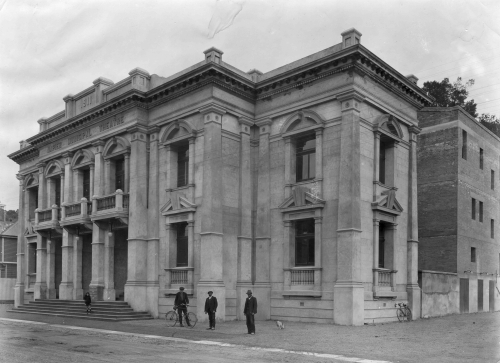
Napier’s Municipal Theatre a labour of love

On 21 December 1911, in front of “a fair attendance” of locals, Mayor Vigor Brown, regally attired in his official robes, laid the new Municipal Theatre’s foundation stone. In his ceremonial speech he referred to the size of the stone, which weighed in at five hundred weight (227 kilograms), by stating that the “bigger the building the bigger the foundation stone should be”. A cavity had been specifically prepared beneath the stone and in this he deposited a bottle containing copies of local newspapers, a selection of New Zealand currency and a copy of Napier Borough Council’s current financial statement.
In 1911 John Vigor Brown had been Mayor for just three years. This colourful and well-known figure was described by Lady Joy Axford in her Dictionary of New Zealand Biography essay as “robust and comfortably dressed, complete with watch and chain, side-whiskers, glasses and top hat”. He was one of Hawke’s Bay top entrepreneurial men - Director of Napier Gas Company, Chairman of various concerns including the White Swan Brewery, Hawke’s Bay Soap and Tannery, Criterion Hotel, Theatre Royal and J Vigor Brown companies.
To perform the ceremony, and as a symbol of the occasion, the building contractors for the theatre, Bull Brothers, presented the Mayor with an ornate silver trowel. This trowel, Vigor Brown declared, would be always treasured as a memento. Ever the egalitarian, he ended his speech by promising that everyone, regardless of social standing, would have the opportunity to attend a performance, as approximately 500 seats would always be set aside at an “affordable admittance price”. This he hoped would prevent exorbitant prices being charged by theatrical companies. At the completion of the Mayor’s speech, Councilor Samuel Carnell called for three cheers from the audience who responded in a “feeble” and unenthusiastic manner”.
Initially the theatre was to be built on a vacant portion of Clive Square, however Amelia Randall, one of Hawke’s Bays wealthiest women and a generous philanthropist, offered land on Tennyson Street at a very reduced rate. On 4 November 1912 the Hawke’s Bay Herald excitedly announced that the new theatre was practically completed. Designed by well-known Melbourne architect, William Pitt, the exterior was in “thorough good taste” although “heavy and massive”. This utilitarian appearance was emphasised by the sides which appeared gaunt and bare, particularly because the Council had removed all mature trees from the surrounds.
The sheer beauty and sumptuousness of the interior belied these initial impressions. When entering one of the three doors from Tennyson Street, the audience was led into a large vestibule housing the ticket offices and cloak rooms. From here a patron could either walk up a sweeping staircase to reach the dress circle, which seated up to 266 people, or alternatively go through one of two doors on either side of the stairs into the stalls, which could accommodate 500. The dress circle opened out to a spacious foyer, off which was a café and cloak rooms. It was from this area that the two boxes overlooking the stage could be entered. The tip-up seats installed in these areas were richly upholstered and comfortable.
This luxurious seating differed from that in ‘the gods’, positioned high above the stage. Instead of entering through the vestibule, the gods was accessed through an outdoor side entrance. Here the furnishings were “not so luxurious”, with platform communal seating that could accommodate up to 700. Despite this, the newspaper emphasised that the gods was “not a place to be despised”, particularly from a spectator’s point of view.
The decoration of the theatre was a special feature entrusted to the Australian firm Coulter and Fulton, ably assisted by local tradesmen. Each decoration was “executed entirely by hand” and comprised beautiful landscapes, raised decorative scrolls and panels of clematis and poppies. Throughout the public spaces of the building, elaborately gilded plaster work prevailed along with handsome friezes depicting reeds, kingfishers, and a variety of flowers. The dome was a delight, being exquisitely painted with a fresco which was surrounded by cupids entwined with roses and foliage. The furnishings, including the seats, carpets, curtains and drop-scene were all in deep blue plush and velvet. The orchestra pit, the entrance of which was cunningly accessed from beneath the stage, could accommodate 20 musicians. It was railed off and protected from the audience with curtains.
The Napier Operatic Society was given the distinction of staging the opening performance, an honour they “worthily fulfilled” by performing the musical comedy A Greek Slave. Before the performance began, Mayor Vigor Brown formally declared the Municipal Theatre open, prior to which he empathically declared that some Napier pessimists thought the theatre too large. He had a contrary opinion - Napier “had the best climate, the best parade, the best baths in New Zealand, then why not the best theatre also”. The theatre, a William Pitt architectural gem, was on a par with Melbourne, Australia.
The Hawke’s Bay Museums Trust collection often has an array of objects that illustrate an occasion, and the opening of the Napier Municipal Theatre in 1911 is no exception. Amongst the objects are numerous images of the exterior and interior of the theatre along with the treasured ceremonial trowel gifted to Mayor Vigor Brown. These items have always been particularly poignant, as this magnificent building, a labour of love led by a small community, was totally destroyed in the 1931 Hawke’s Bay earthquake –a mere 20 years after the official opening.
Published in the Hawke’s Bay Today newspaper on 9 March 2024 and written by Gail Pope, Social History Curator at MTG Hawke’s Bay.
Image: The exterior of the Napier Municipal Theatre, 1911
11 March 2024



